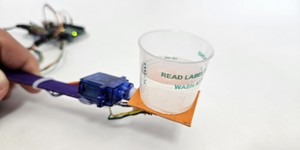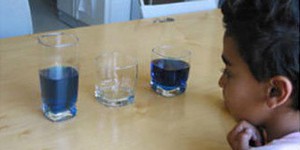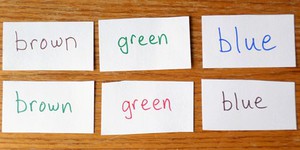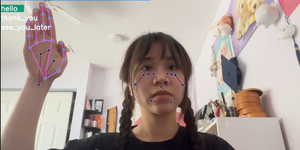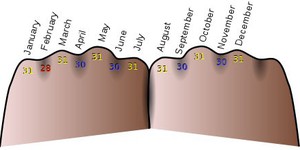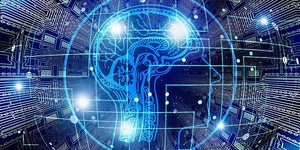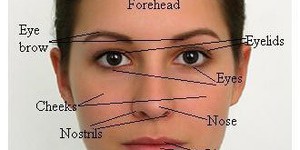Middle School, Human Behavior Science Projects (40 results)
If you're interested in learning more about how people think, what motivates them, how well their memories work, or any other of the fascinating things that make us human, then you're in the right place!
|
Select a resource
Coding Projects
Sort by
|
How do you feel right now? Do you remember how you felt a few hours ago? How about yesterday or last Wednesday? What if you could track your emotions throughout the day and use this information to help improve your mood and well-being? In this science project, you will program a simple, pocket-sized device that you can carry around with you to log your feelings whenever you want or on a specific schedule.
Read more
Can you tell if the pictures on this page are real or generated by a computer? Artificial intelligence (AI) generated images have exploded in popularity, bringing plenty of controversy along with them. An AI-generated image of a tiger or a flower might seem harmless, but artificial images of people or events can contribute to "fake news." In this science project you will investigate whether people can tell the difference between real pictures and pictures generated by AI. Can you spot the…
Read more
New
Have you ever seen a waiter balance an entire tray of drinks without spilling any? How do they do it? Do you think you could build a robot waiter that can do the same thing? In this project, you will learn how to build a self-balancing robotic tray. You can incorporate the auto-leveling tray into one of our many other robotics projects, like the Bluebot or robotic arm.
Read more
Artificial intelligence (AI) programs can now generate photorealistic pictures of people who do not exist in the real world. How can you tell if a picture is of a real person or a fake, AI-generated person? What features of the picture do people use to decide whether the face is real or AI-generated? In this project, you will explore these questions as you ask volunteers to look at both real and AI-generated pictures of human faces.
Read more
Having a younger brother or sister can be a real chore. They can get into your things and mess up all your stuff. But have you ever thought that when younger siblings do this kind of thing, they are actually learning about the world around them and how to interact with their environment? Every day, a young child's brain is getting new information about his or her environment and developing ways to organize that information. Learning about and understanding this conduct is the study of human…
Read more
Can you pat your head with one hand while you rub your stomach with the other? This science project idea is kind of like doing that, but this project can actually give you some insight into how your mind works. The task is to name colors. It sounds simple enough, but see what happens when color words get in the way.
Read more
New
Can AI understand human language? In the future, AI could aid in emergency interpretive service in the hospital when translators aren't available. But can current AI algorithms understand non-verbal languages like sign language? In this science project, you will test whether AI can learn sign language gestures or phrases to see if it can be used for interpretation.
Read more
You know how to make new colors by mixing paint or crayons. For example, you get green by mixing yellow and blue, or orange by mixing red and yellow. With paint, blue, yellow, and red are primary colors, which you can use to make other colors. Have you ever tried making colors with light? Are the primary colors the same ones you use for paint? Do this experiment and find out.
Read more
Psychologists have long studied why people find certain faces more attractive than others. One interesting method used in this area of research is mixing several faces together to make a composite face. The composite face averages the input faces, so that small, non-symmetric features tend to get lost. In this human behavior science project, you will use an online tool to make composite faces, and determine how they compare to real faces in perceived attractiveness.
Read more
Have you ever had to remember a long list of planets or the state capitals? These kinds of lists are full of interesting facts, but they can be hard to remember, especially for tests. What could you do to remember the list better? In this human behavior science fair project, you will learn about a memory technique called mnemonics (pronounced nuh-MAH-nicks) and investigate whether using mnemonics can help you and your friends remember lists of words.
Read more
AI (artificial intelligence)-generated text is a hot topic for many reasons. Computers can now generate convincing paragraphs or even pages of text that look like they were written by a human. How do you know if a news article you are reading was written by a human or an AI? How does a teacher know if a student's essay was written by an AI? How do you know this text was not written by an AI? In this science project, you will conduct an experiment to see if volunteers can correctly identify…
Read more
Okay, now you've done it. You goofed off, didn't study for your math test, and didn't do well. Mom and Dad are not going to be happy. In fact, they might even be angry. They don't say anything when they see your test, but you can tell from their faces that they are angry. But how can you tell? How can you tell if someone is angry, or happy, or sad? The answer is that you have learned how to tell someone's emotional state from his or her facial expressions. Are facial expressions of happiness or…
Read more
|




